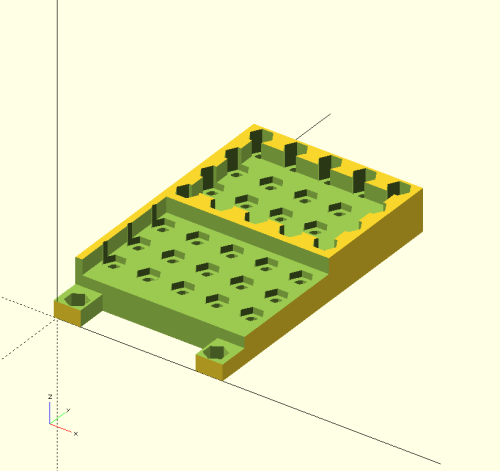This is an old revision of the document!
Table of Contents

(remove this paragraph once the translation is finished)
Compatibility with other construction sets and systems
MLAB is a constructions set that uses the open source principles to maximise the compatibility with other standard construction solutions. Thus it is an exact opposite e to vendor-lock solutions.
Mechanically compatible systems
MLAB uses an internally standardised hole pitch 10.16 mm (400mils) for attaching the modules to other parts of the system. This pitch is a compromise between a metric and an inch technical worlds and makes their connections possible. Therefore, there are many standards that are compatible with MLAB kit.
Currently, these possibilities of mechanical integration are even bigger thanks to the onset of 3D printing technologies. It can be conveniently used to construct and produce a very accurate mechanical adapters between two different systems / standards. An example of such approach is the creation of mechanical and electronic adapters for single-board ODROID computers (see below).
Merkur
MLAB kit is compatible with MERKUR construction kit mechanically and electronically. However, there are certain specifics that need to be taken into consideration.
First, the compatibility with MERCUR in a sense that the MLAB modules fit into MERCUR pitch is only applicable in a certain range of module sizes. It is caused by a fact that MLAB modules do not have the pitch of exactly 10 mm, but 0.4“.
However, this property does have its advantages - if MLAB modules would fit into the MERCUR hole pitch exactly, it would be possible to mount them on any place and to any piece of the kit. That is however not technically correct, because for example a module’s PCB cannot be used as a carrier part of a device. During module deformation, electronic components that it bears on itself may be damaged. For this reason, bigger modules that cannot be directly fit into MERCUR boards have to be connected via a reduction board that contains holes with the correct pitch (in case of small modules, this problem does not exist). An example of such reduction board is a duralumin basic board ALBASE with a metric 10mm hole pitch on its circumference.
Another reason for using a reduction board is, that most MLAB modules are constructed in a way that there is a common ground potential on MERCUR fastening screws (?? Upevňovací), improving the electrical characteristics of the system and its immunity against interference and radiating. When using a standard MERCUR painted kit pieces, this feature is suppressed. That may lead to complications or (especially in case of analogue circuits) cause a different behaviour compared to using an MLAB base board.
The biggest module that can be flawlessly used with Mercur has a size of approximately 5 holes.
Makeblock
Electrically compatible systems
Due to a fact that MLAB kit mostly uses a standard electronically interfaces and protocols, electrical connections with many existing systems are possible. In this case, a limiting factor is often a mechanical compatibility, which may be usually solved by using a mechanical adapter.
.NET Gadgeteer
This construction kit uses a metric hole pitch 5 mm and electric signals are merged into flat cables. Therefore, it is necessary to use both mechanical and electronic reductions. Using mechanic reductions with this kit is highly recommended, because Gadgeteer’s PCBs are quite delicate and are easy to damage by pressure during usage (especially modules with buttons).
SparkFun breakout boards
Despite their widespread presence, SparkFun development boards are very unstandardised. The corner holes on their modules have basically a random pitch. Signals are led out onto pins with pitch 100mils, therefore they can be connected with MLAB via usual cables.
Mechanical reductions can be designed for individual Breakout boards and print on a 3D printer.
Mikroe development kits
These kits are similar to PCB manufactured by SparkFun in their characteristics and the same principles of adapters construction can be applied to them.
Single-board computers Hardkernel - ODROID
Tyto počítače byly kvůli svým vlastnostem do MLABu asimilovány jako řešení pro automatizaci a robotizaci rozsáhlejších systémů. K tomu bylo potřeba vyřešit jejich odolnost proti mechanickým vlivům, jako jsou vibrace a nárazy.
Proto byl vyvinut přístup, který umožňuje návrh a výrobu velmi univerzálních mechanických adaptérů do MLAB stavebnice. Toto řešení využívá nejrozšířenější a nejlevnější technologie 3D tisku MDF. Adaptér je pak konstruovaný tak, že obsahuje sadu děr pasujících do rozteče MLAB a dále díry, které slouží pro přichycení desky pro kterou je adaptér konstruován.
Celá konstrukce je zároveň optimalizována pro použití 3D tisku.
Programová kompatibilita
Arduino
Pro použití Arduina v kombinaci s moduly MLAB existuje několik možností. Liší se především tím, zda se chystáte používat Arduino shieldy, nebo ne.
Pokud použítí shieldů nevyžadujete a stačí vám pouze programová kompatibilita, tak je pro vás ideální použití LABduina.
Pokud je pro vás použití shieldů nezbytné, tak je třeba si vyrobit redukci.
Ostatní standardy
- elektroinstalační krabice, rozvaděče
Optika
- optické stoly, čočky, moduly a objímky.
Optické stoly mají podobně jako většina technických standardizovaných dílů buď metrickou rozteč 25mm a nebo 1” tedy 25.4mm. Rozdíl mezi těmito rozměry je proto znatelný až na rozměrnějších záležitostech.
Základní deska může však být díky svojí konstrukci přichycena k oběma typům stolů.
Pneumatika
Při konstruování pneumatických zařízení je v MLABu nejvýhodnější používat systém nástrčných šroubení a pneumatické díly šroubovat k základní desce podobně jako moduly.
DIN rozvaděče
Do rozvaděčů a skříní s DIN lištami lze moduly MLAB instalovat namontované na cuprexitové základní desce. Tuto desku je potřeba potřeba opatřit plastovými svorkami na DIN lištu. Podrobnější popis tohoto postupu najdete v návodech.

